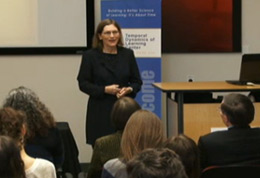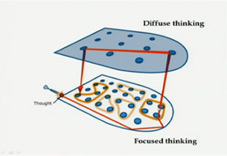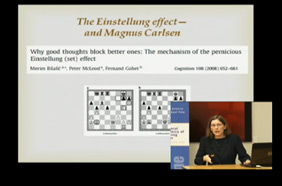TDLC Webinar
How to Learn More Deeply and Creatively: Concrete Tools from Neuroscience and from Zombies

March 12, 2013
Featured Speaker: Barbara Oakley
Author and Associate Professor in the School of Engineering
and Computer Science at the University of Oakland
About the Event
This fascinating presentation was sponsored by TDLC and TDLC's Educator Network (coordinated by Doris Alvarez) in celebration of Brain Awareness Week (BAW) -- the global campaign to increase public awareness of the progress and benefits of brain research. Over 215 people registered for the Webinar, with 150 attending in person. The audience consisted of TDLC researchers and over 75 high school students and their teachers. The Webinar streamed to over 100 participants from states such as Colorado and New York, and to countries as far away as Poland, Canada, Australia, and Portugual. The Distinguished Educator Advisory panel was primarily responsible for the large number of students, educators and members of the community in attendance.
The Presentation
Barbara Oakley captivated the packed auditorium with her discussion of the brain and different ways of thinking about thinking. She discussed the two modes of thinking -- focused mode and diffuse mode. She elaborated on an evolutionary conflict in which animals need careful, focused intent (searching for food) but also depend on diffuse intent (looking for danger) to survive.

"What did evolution come up with to solve this problem?" We have separate lobes of our brain, with left being more focused, and right showing more visual-spatial diffuse attention. Recent research finds neurological differences between the modes of thinking, and shows evidence that both modes of processing in the brain are very important.
Since it is difficult to think in both modes simultaneously, a person usually works in one mode at a time. Barbara Oakley then used fascinating examples -- Salvador Dali, a famous artist, and Thomas Edison, a famous inventor -- to show how successful people through history have developed creative ways to "switch attention" -- to change from focused to diffuse mode thinking. Both Dali and Edison created situations where they were forced to drop an object when in a deep state of relaxation, causing a sudden switch of attention.

Barbara Oakley was able to engross the audience in her ideas by sharing information, then asking the audience to discuss in small groups. This encouraged recall and practice of information - essentially "practicing what she preaches" and doing exactly what she was teaching us to do! Using the latest research about how the brain works, she shared priceless strategies on how to learn optimally, improve test-taking, combat procrastination, and better retain information. Some of these ideas include:
- Alternate focused thinking with diffuse thinking / relaxation; Switching attention when you get "stuck" allows the mind to continue to process the information in another area of the brain.
- Experiment with "hard start" - start with the hardest problems and move on if you can't get it (switch attention), then come back to it later. This break in focused attention allows the prefrontal cortex or "attention" part of the brain to "get out of the picture" so other parts of the brain can make connections and process the information in other ways.
- Shift your focus of attention to try to counteract the Einstellung effect (in which good thoughts block better ones).
Ways to shift attention: Sleep, relax, or shift your gaze. - Practice makes permanent; Repetition is really important, and memory is very important in mastering material.
- Working memory has seven slots/numbers before it is filled. To free up working memory, turn the information pieces into a chunk by PRACTICE. Experts create a library of chunks (e.g. chess masters).
- Commmit key ideas to memory using simple memory tricks.
- Free working memory by making a list.
- Recall the material - read, look away and recall/retrieve, look back again.
- Procrastination is a habit that can be changed. Use the Pomodoro Technique, set a timer for 25 minutes (or any reasonable finish time). Make subtle changes to the cues that make you want to procrastinate.
- When you are done, RELAX. You need your diffuse time.
- Your senses activate different areas of your brain. Activate as many as you can when learning, to activate as much of your brain as you can.

In essence, Barbara Oakley helped us more effectively "learn how to learn!"

Panel Featuring the Distinguished TDLC Scientists (Paula Tallal, Andrea Chiba, Terry Sejnowski)
Summing It Up
Alternate focused attention with relaxation
Problems are like songs - problem-solving is like learning music -
you need to practice it
Experiment with "hard start" - start with the hardest problems earlier
Procrastination is a habit - one that you can change
Commmit key ideas to memory using simple memory tricks
Learn how to learn